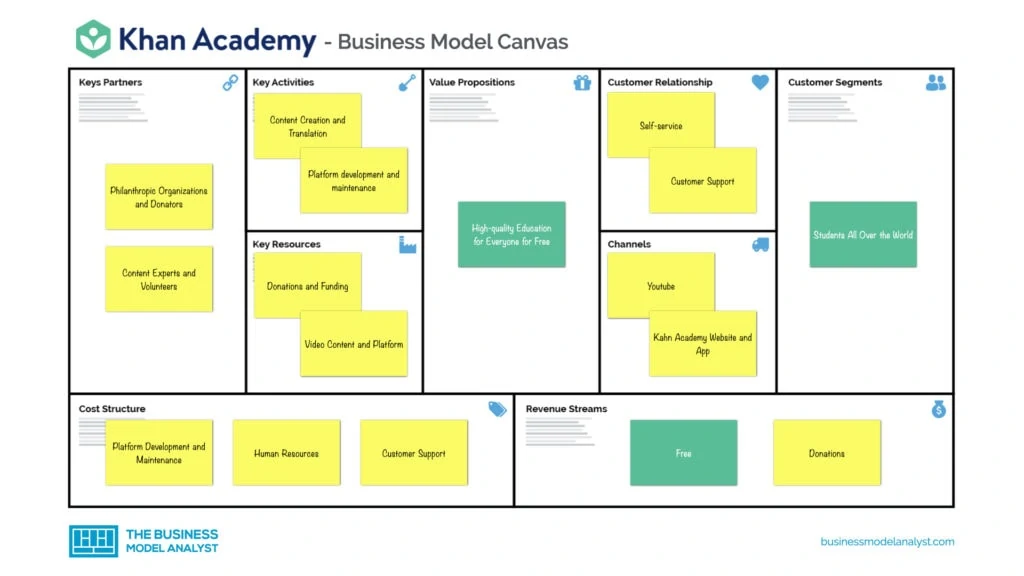The Khan Academy business model is a non-profit educational organization, that has built “just” the largest school in the world, available in over 190 countries and already visited by more than 50 million students, since its foundation.
The school, created by Sal Khan, produces video and interactive content for learning, all for free, through its online platform (website and app). The videos, which started with only mathematical ones developed by the founder, now cover all school subjects, for all grades, from kindergarten to high school. The learning experience in Khan Academy is based on the educational videos, which are all hosted on YouTube. Additionally, the website and app contain supplement activities to the videos, with other tools and exercises for practicing. And, to reach students all over the world, volunteers have translated the material into 28 different languages. Even some non-profit groups have distributed offline versions of the material in rural areas with little access to the web, in Asia, Latin America, and Africa.
But, although Khan Academy offers educational content at no cost, this business model generates annual revenue of around 8 digits. How can that be?
Contents
Khan Academy Business Model Canvas in a nutshell

- Customer segments: students all over the world, aiming for some extra help over all kinds of subjects, from kindergarten to high school.
- Value proposition: providing high-quality education for free, with videos and supplementary materials developed by experts and translated into several languages.
- Channels: YouTube channel, website, and app.
- Customer relationships: providing content, in a noncommercial, online, and personalized learning experience.
- Revenue streams: donations, mostly from philanthropic organizations.
- Key resources: donations and funding, videos and other content, YouTube channel, online platform, volunteers and experts, and the reputation.
- Key activities: content creation, as the platform provides educational content. Besides that, there are platform maintenance, content translation, customer support, financials, public relations etc.
- Key partners: philanthropic organizations, donators, content experts, translators, and other volunteers.
- Cost structure: platform development and maintenance, human resources, network management, and help center.
How does Khan Academy make money?
As mentioned above, Khan Academy is a non-profit organization. Most donations come from philanthropic organizations, and the donations are accountable for maintaining the business and all its resources, including salaries. Some donators include:
- Ann Doerr
- Google ($2 million)
- Carlos, Slim, from Carlos Slim Foundation in Mexico
- At&T ($2.25 million)
- The Bill & Melinda Gates Foundation ($1.5 million)
- Netflix CEO Reed Hastings
- NewSchools Venture Fund
- JA and Kathryn Albertson Foundation
- Oracle
- Walt Disney Foundation
- Hyatt Hotels Corporation
Moreover, according to a YouTube analysis, Khan Academy also takes is over $500,000 per year, from its channel. How this revenue fits into a non-profit organization is not clear yet. The total revenue of the organization in 2018, for example, surpassed $42 million. Salman Khan’s salary, as CEO, was $824,000 (annual).
How was Khan Academy built?
The idea was born in 2004, when Sal Khan was his cousin’s tutor. When other relatives and friends began to ask for help too, he decided to provide his classes via YouTube videos. Two years later, he resolved to offer high-quality education to all, for free.
As the organization grew, Khan Academy became a non-profit and started to attract donators. The first donations came from Ann Doerr, the wife of billionaire venture capitalist John Doerr. And was soon followed by names such as Google and The Bill & Melinda Gates Foundation. When Khan started, the videos were all on mathematics. Now, the website offers content about astronomy, biology, chemistry, economics, healthcare, history, medicine, music, and other 5,000 subjects. The material is developed by experts, in order to provide a valid and effective learning experience. Nowadays, the organization in divided into two segments:
- Khan Academy: online platform, free of charge, for students around the world, and
- Khan Lab School: a physical location, founded in 2014 In Mountain View, California. It’s an independent school, where everyone is viewed both as a student and a teacher.
Why is Khan Academy criticized?
Some criticism against Salman Khan is due to his lack of formal qualification in pedagogy. According to the founder, the academy will never constitute a complete education. Its objective is simply supplementing learning, by helping individual needs. Sal Khan also states that the online constitution of the content allows fast corrections, which is a benefit:
“That’s one of the values of this form over a traditional textbook, where you get little or no feedback. When we put content out, 10,000 people look at it within a week. It’s a very fast editorial cycle. We don’t have to wait until the next textbook. We can fix it overnight.” For the ones who want to know more about Sal Kahn and his venture, he published a book, names The One World Schoolhouse, in 2012. The book tells the story of Khan Academy and outlines the author’s vision of the future of education.



Wassup man, Salman Khan is an amazing person! But… I think he deserves more money because his program is all over the world!